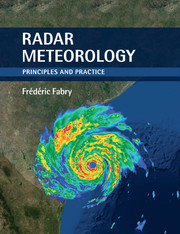Book contents
- Frontmatter
- Dedication
- Contents
- Preface
- Notation
- 1 Meteorology and radar
- 2 Fundamentals of weather radar measurements
- 3 Radar reflectivity and products
- 4 Reflectivity patterns
- 5 Doppler velocity information
- 6 The added value of dual polarization
- 7 Convective storm surveillance
- 8 Monitoring widespread systems
- 9 Radar estimation of precipitation
- 10 Nowcasting
- 11 Additional radar measurements and retrievals
- 12 Cloud and spaceborne radars
- 13 What does radar really measure?
- Appendix A Mathematics and statistics of radar meteorology
- References
- Index
2 - Fundamentals of weather radar measurements
Published online by Cambridge University Press: 05 June 2015
- Frontmatter
- Dedication
- Contents
- Preface
- Notation
- 1 Meteorology and radar
- 2 Fundamentals of weather radar measurements
- 3 Radar reflectivity and products
- 4 Reflectivity patterns
- 5 Doppler velocity information
- 6 The added value of dual polarization
- 7 Convective storm surveillance
- 8 Monitoring widespread systems
- 9 Radar estimation of precipitation
- 10 Nowcasting
- 11 Additional radar measurements and retrievals
- 12 Cloud and spaceborne radars
- 13 What does radar really measure?
- Appendix A Mathematics and statistics of radar meteorology
- References
- Index
Summary
Radar: an active remote sensor
To gather information about the world around us, we rely on a variety of sensing mechanisms. Some, such as touch or taste, are based on in situ sensing: the sensor must be in direct contact with an object to gather information about it. Others, such as sight, use remote sensing: the sensor can be some distance away from the object. For remote sensors to work, information must travel between the object and the sensor. Most remote sensors rely on the detection of acoustic waves (sound) or electromagnetic (EM) waves (light, heat, and radio waves, among others) to gather that information.
While the applications of remote sensing are extremely varied, the principles and the process of data gathering are extremely similar. Most remote sensors basically measure the energy received for certain ranges of wavelengths, preferably from a given direction, as a function of time. That energy is either emitted or reflected by the object observed.
Radar, an acronym for RAdio Detection And Ranging, refers to an instrument that emits a strong signal at radio or microwave frequencies and then listens for echoes that occur if the signal reflects off objects known as targets (remember, radar was first a military instrument). And since it provides illumination to the target – like a camera and a flash do, and unlike the way our eyes rely on an external source such as the Sun – it is referred to as an active remote sensor.
Because of the need for an energy source, active remote sensors such as radars tend to be more complex than passive remote sensors such as satellite imagers. But that extra complication comes with benefits. Since we know what was transmitted and when, active remote sensors can make additional measurements compared to passive sensors: How much time elapsed between the transmission of the signal and the reception of the echo? How strong is the signal compared to what was transmitted? Has the frequency or the polarization of the signal changed? These crucial pieces of information give us additional clues on the object being studied, as well as on the medium between the sensor and the object.
- Type
- Chapter
- Information
- Radar MeteorologyPrinciples and Practice, pp. 8 - 31Publisher: Cambridge University PressPrint publication year: 2015
- 1
- Cited by



